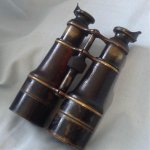Hi Lee,
My glasses introduce CA of their own, although I don't wear them when using binoculars.
I use the full Moon to see how much change in magnification there is at the edges.
Nowadays I don't like magnification change or CA, although I may have tolerated it years ago.
The strangest experience really was using a top quality Ross 100mm f/15 triplet objective. There was no false colour of any kind and it seemed bizarre for a refractor.
5,000 not out Lee, hopefully.
Congratulations.
Many thanks David
Lee







